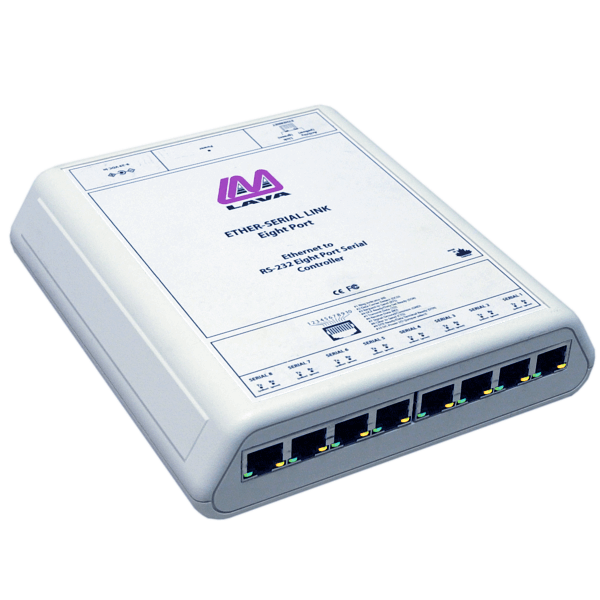Why continue to use dedicated PCs as serial port servers? LAVA Ether-Serial Links (remote serial port devices for Ethernet networks) provide a simple way to deploy serial ports over Ethernet for cost savings and increased reliability. Programs that communicate using serial ports on a PC can also directly access and control the serial ports of a LAVA Ether-Serial Link. Specialized networking software or program re-design is not required.
Serial ports once limited by the 50-foot cable requirements of RS-232 serial communications can be deployed at any distance, even over the Internet. Understanding the technology and design of LAVA Ether-Serial Links makes it clear why these devices are the “best of breed” among serial-to-Ethernet technologies.
An Ether-Serial Link is the most versatile and hassle-free means of sending serial communications over an Ethernet, while eliminating the obstacles to network serial technology. Other network serial products require:
- familiarity with Ethernet/Internet communications protocols
- networking programming experience
- knowledge of client/server technology and procedures, or close familiarity with TCP/IP.
The LAVA Ether-Serial Link makes none of these demands on system integrators as it is engineered to be intuitive for end users. While many network serial products are rooted in Ethernet, LAVA takes a different approach. Serial ports inside LAVA Ether-Serial Links are designed from the outset to be serial ports – so they appear as native COM ports to the end user.
What’s the difference? An Ethernet interface to a serial port isn’t the same as a remote serial port accessible over Ethernet. While it’s true that once implemented, both technologies will do the same thing, it’s also true you can hammer nails with a screwdriver.
Serial ports in a LAVA Ether-Serial Link are true native COM ports. They appear in Windows Device Manager as internal COM ports, just like in your PC now.
ANY software that needs to communicate with a COM port can communicate with the COM ports of an Ether-Serial Link. This means even software running in a DOS window in Windows. Few, if any other serial-to-Ethernet devices can make that claim.
At LAVA, we view the Ethernet in the same way as the PCI bus – not just as a transport medium for data transmission, but as a tool to make hardware to Connect Simply. For this reason, LAVA Ether-Serial Links use the Ethernet in much the same way as serial port expansion cards use Plug and Play on the PCI bus. PCs running LAVA Discovery Protocol can automatically detect Ether-Serial Links on their Ethernet subnet. With proper permissions, they can be configured to use those serial ports, with no manual input of network parameters or device settings.
Communications Reliability & Security. Data exchanges between the PC and the LAVA Ether-Serial Link are sent through the network over TCP/IP. The TCP protocol, by design, provides reliability for the data transfer. LAVA’s data transport protocol adds additional data integrity, along with a specialized layer for an added dimension of security. Data integrity is also handled by the nature of serial connection itself, with its attendant error checking, flow control, handshaking, and buffering.
Configuration and control commands are handled by the LAVA Discovery Protocol. This protocol has a 24-byte security key that secures access to LAVA Ether-Serial Links, preventing unauthorized admission. By design, LAVA Discovery Protocol commands expect acknowledgments, guaranteeing integrity and successful execution, despite the fact they use UDP’a protocol that does not expect acknowledgment of receipt of data.
At the application level, any required encryption or special data handling procedures can be easily implemented. In addition, standard Internet security procedures can be introduced on the network side as required.
The LAVA Discovery Protocol & the Ether-Serial Link Driver Explained. Ether-Serial Links carry data over the Ethernet using standard Ethernet packets and TCP/IP. LAVA Ether-Serial Links use another type of communication?the LAVA Discovery Protocol to exchange instructions and manage information from PCs. This protocol, in combination with the Ether-Serial driver, makes LAVA Ether-Serial Links powerful yet easy to use.
The LAVA Discovery Protocol is installed as a part of the driver that handles communications between Ether-Serial Link ports and programs running on a computer (such as POS software, industrial control software, or any software that communicates with a serial port). Everything between the software accessing a serial port and the Ether-Serial Link is handled by the LAVA driver transparently. Your operating system sees the PC as having additional serial ports. These ports operate just like any other serial port. The LAVA Discovery Protocol can:
- find LAVA Ether-Serial Links operating on a user’s network segment,
- set or alter operating parameters such as network or serial port line settings,
- install Ether-Serial Links on a network.
The structure of the LAVA Discovery Protocol also provides “device permanence” for Ether-Serial Link configurations. Once it has been installed, a LAVA Ether-Serial Link will maintain or re-acquire its operating parameters through a power on/off cycle. Similarly, a PC will retain its “installed” Ether-Serial Link ports after rebooting.
Establishing Communications. LAVA Ether-Serial Link communications use a defined Ethernet packet structure to communicate between host PCs and a LAVA Ether-Serial Link. Initial contact is made when a PC broadcasts a message to MAC addresses that are recognized. This broadcast will invoke a response from any LAVA Ether-Serial Link that accepts broadcast from an issuing PC. Just as with a PCI board, an Ether-Serial Link has a LAVA Vendor ID and a Device ID. In its response to the initial broadcast, the Ether-Serial Link will include identifiers. Communications between the Ether-Serial Link and the PC can be established.
The LAVA Discovery Protocol Datagram. A LAVA Discovery Protocol datagram is an Ethernet packet that can contain such information as the identities of the sender and recipient of the datagram. It includes commands to:
- discover Ether-Serial Links on a network segment;
- request and submit detailed devices information from an Ether-Serial Link;
- upgrade an Ether-Serial Link’s firmware;
- manage security, reboot, or reset Ether-Serial Links.
Using the LAVA Discovery Protocol, an Ether-Serial Link can provide detailed information about:
- network parameters;
- current port settings;
- hardware profile, including production date, PCB revision, MAC address, CPU, UART and NIC type, jumper settings, memory information; firmware version; and more.
In addition to a Windows-based management interface for Ether-Serial Links, many of the capabilities of the LAVA Discovery Protocol are presented in HTML pages served by an embedded web server in the Ether-Serial Link. This powerful and easy-to-use interface is available anywhere a TCP/IPs connection to the Ether-Serial Link exists. Connect Simply!
LAVA Computer MFG headquartered in Toronto, ON, Canada, designs and manufactures serial parallel I/O boards and Ethernet-to-serial device servers widely used in Point of Sale, Kiosk, Gaming, Industrial Automation, Hospitality, Telecom, Security & Access Control industries. With well over a million LAVA products built into workstations, servers, and POS systems since 1984, LAVA I/O boards and Ether-Serial Links are trusted by resellers, distributors, OEM’s and system builders in over 47 countries worldwide. Designed for lifetime performance, each LAVA connectivity link is individually tested and covered by the LAVA Lifetime Warranty.


